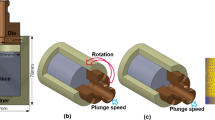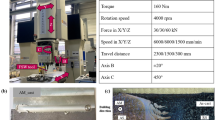Abstract
Friction stir welding (FSW) now definitively reached a large interest in the scientific community and what is more in the industrial environment, due to the advantages of such solid state welding process with respect to the classic ones. The latter aspects are relevant also with reference to joints characterized by a complex geometry. What is more, advanced FEM tools permit to develop effective engineering of the processes; quantitative results can be acquired from numerical simulations once basic information, as the process mechanics and the material flow, are certain. Material flow plays a fundamental role in FSW since it determines the effectiveness of the joints or, in turn, the insurgence of defects. In the paper, the material flow in the FSW of aluminum alloys T-joints is investigated at the varying of the most relevant technological and geometrical parameters with numerical simulations and experiments. In particular, to investigate the metal flow, a wide campaign of experimental tests and observations was developed utilizing a thin foil of brass as marker, placed at the interface of the two blanks to be welded. Some relevant conclusions on the process mechanics and on the actual material flow determining the material bonding are outlined, permitting an insight of the FSW of T-joints.
Similar content being viewed by others
References
Teng TL, Fung CP, Chang PH, Yang WC (2001) Analysis of residual stresses and distortions in T-joint fillet welds. Int J Press Vessels Piping 523–538
Mashiri FR, Zhao XL, Grundy P (2004) Stress concentration factors and fatigue behaviour of welded thin-walled CHS-SHS T-joints in-plane bending. Eng Structures 26:1861–1865, doi:10.1016/j.engstruct.2004.06.010
Carpinteri A, Birghenti R, Huth H, Vantadori S (2005) Fatigue growth of a surface crack in a welded T-joint. Int J Fatigue 27:59–69, doi:10.1016/j.ijfatigue.2004.05.007
Shaikh H, Khatak HS, Mahendran N, Sethi VK (2003) Failure analysis of a T-joint of AISI type 316L stainless steel. Eng Fail Anal 10:113–118, doi:10.1016/S1350-6307(02)00040-7
Pang HL, Pukas SR (1989) Residual stress measurements in a Cruci-form welded joint using hole drilling and strain gauges. Strain 25:7–14
Finch DM, Burdekin FM (1992) Effect of welding residual stresses on significance of defects in various types of welded joints. Eng Fract Mech 41(5):721.735
Ma NX, Ueda Y, Murakawa H, Madea H (1995) FEM analysis of 3D welding residual stresses and angular distortion in T-type fillet welds. Trans JWRI 24(2):115–122
Fratini L, Buffa G, Filice L, Gagliardi F (2006) FSW of AA6082-T6 T-joints: process engineering and performance measurement. J Eng Manuf Part B, ISSN: 0954-4054 220(5):669–676
Liu HJ, Fujii H, Maeda M, Nogi K (2003) Tensile properties and fracture locations of friction-stir-welded joints of 2017-T351 aluminium alloy. J Mater Proc Tech 142:692–696, doi:10.1016/S0924-0136(03)00806-9
Rhodes CG, Mahoney WH, Bingel MW, Spurling RA, Bampton CC (1987) Effects of friction stir welding on microstructure of 7075 aluminium. Scr Mater 36(1):69–75, doi:10.1016/S1359-6462(96)00344-2
Guerra M, Schmidt C, McClure LC, Murr LE, Nunes AC (2003) Flow patterns during friction stir welding. Mater Charact 49:95–101, doi:10.1016/S1044-5803(02)00362-5
Su JQ, Nelson TW, Mishra R, Mahoney M (2003) Microstructural investigation of friction stir welded 7050-T654 aluminium. Acta Mater 51:713–729, doi:10.1016/S1359-6454(02)00449-4
Shigematsu I, Kwon YJ, Suzuki K, Imai T, Saito N (2003) Joining of 5083 and 6061 aluminium alloys by friction stir welding. J Mater Sci Lett 22:343–356, doi:10.1023/A:1022688908885
Lee WB, Yeon YM, Jung SB (2003) The improvement of mechanical properties of friction-stir-welded A356 Al alloy. Mater Sci Eng A355:154–159
Barcellona A, Buffa G, Fratini L (2004) Process parameters analysis in friction stir welding of AA6082-T6 sheets, Keynote paper of the VII ESAFORM Conference 371–374
Peel M, Steuwer A, Preuss M, Withers JP (2003) Microstructure, mechanical properties and residual stresses as a function of welding speed in aluminium AA5083 friction stir welds. Acta Mater 51(16):4791–4801, doi:10.1016/S1359-6454(03)00319-7
Song M, Kovacevic R (2003) Thermal modeling of friction stir welding in a moving coordinate system and its validation. Int J Mach Tools Manuf 43:605–615, doi:10.1016/S0890-6955(03)00022-1
Schmidt H, Hattel J, Wert J (2004) An analytical model for the heat generation in friction stir welding. Model Simul Mater Sci Eng 12:143–157, doi:10.1088/0965-0393/12/1/013
Chao YJ, Qi X, Tang W (2003) Heat transfer in friction stir welding—experimental and numerical studies. Trans ASME 125:138–145
Chen CM, Kovacevic R (2003) Finite element modeling of friction stir welding—thermal and thermomechanical analysis. Int J Mach Tools Manuf 43:1319–1326, doi:10.1016/S0890-6955(03)00158-5
Lockwood WD, Reynolds AP (2003) Simulation of the global response of a friction stir weld using local constitutive behavior. Mater Sci Eng A 339:35–42, doi:10.1016/S0921-5093(02)00116-8
Xu S, Deng X (2002) A three-dimensional model for the friction-stir welding process, Proceedings of the 21th Southestern Conference on Theoretical and Applied Mechanics, Orlando
Xu S, Deng X (2003) Two and three dimensional finite element models for the friction stir welding process, Proceedings of the 4th International Symposium on Friction Stir Welding, Park City
Deng X, Xu S (2001) Solid mechanics simulation of friction stir welding process. Trans NAMRI/SME. SME 29:631–638
Buffa G, Hua J, Shivpuri R, Fratini L (2006) A continuum based FEM model for friction stir welding-model development. Mater Sci Eng A 419(1–2):389–396, doi:10.1016/j.msea.2005.09.040
Buffa G, Hua J, Shivpuri R, Fratini L (2006) Design of the friction stir welding tool using the continuum based FEM model. Mater Sci Eng A 419(1–2):381–388, doi:10.1016/j.msea.2005.09.041
Li Y, Murr LE, McClure JC (1999) Flow visualization and residual microstructures associated with the friction-stir welding of 2024 aluminium to 6061 aluminium. Mater Sci Eng A 271:213–223, doi:10.1016/S0921-5093(99)00204-X
Fratini L, Buffa G, Palmeri D, Hua J, Shivpuri R (2006) Material flow in FSW of AA7075-T6 butt joints: continuous dynamic recrystallization phenomena. ASME J Eng Mater Technol 128:428–435, doi:10.1115/1.2204946
Fratini L, Buffa G, Palmeri D, Hua J, Shivpuri R (2006) Material flow in FSW of AA7075-T6 butt joints: numerical simulations and experimental verifications. Sci Technol Weld Join 11(4):412–421, doi:10.1179/174329306X113271
Buffa G, Fratini L, Micari F, Shivpuri R (2008) Material flow in FSW of T-joints: experimental and numerical analysis. International Journal of Material Forming, doi:10.1007/s12289-008–0137-6
Author information
Authors and Affiliations
Corresponding author
Rights and permissions
About this article
Cite this article
Fratini, L., Buffa, G., Micari, F. et al. On the material flow in FSW of T-joints: Influence of geometrical and tecnological parameters. Int J Adv Manuf Technol 44, 570–578 (2009). https://doi.org/10.1007/s00170-008-1836-3
Received:
Accepted:
Published:
Issue Date:
DOI: https://doi.org/10.1007/s00170-008-1836-3




